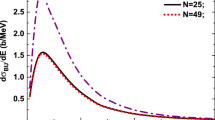Abstract
The ground state wave function of11Li obtained in a three-body model proposed earlier (S Kumar and V S Bhasin,Phys. Rev. C65, 034007 (2002)) has been employed to study the probability distributions, momentum distributions and n−n correlation. Complex scaling method has been used to find the energy positions and widths of the three resonant states of11Li above the breakup threshold. The formalism is extended further to study the β-decay of11Li to two channels. One is the β-transition of11Li into a high lying excited state of11Be at 18.3 MeV, i.e.,11Be* and the second is the decay to deuteron +9Li channel. The11Be* state has been considered as a halo analog state identified as a bound three-body (9Li + n + p) system. The n-9Li interaction incorporates both the virtual state and the p-wave resonance observed experimentally. For p-9Li interaction, a Coulomb corrected separable interaction is constructed using charge indepedendence for strong interaction part. The n-p interaction is operative only in3S1 state corresponding to the isotopic spin Th =0. As a result the11Be* state has the same isotopic spin as that of9Li core, i.e.,T = 3/2. Using these realistic parameters as input and without invoking any other free parameter, the model has been used to predict the strength of the Gamow-Teller β-decay of11Li to11Be*, i.e.,Bgt = 1.5 and the value of the branching ratio to9Li + deuteron channel to be 1.3 × 10-4. These results are found to be in rather good agreement with the recent experimental findings.
Similar content being viewed by others
References
I Tanihata,Nucl. Phys. A488, 113c (1988)
A C Mueller and B M Sherrill,Annu. Rev. Nucl. Part. Sci. 43, 529 (1993)
M V Zhukov, B V Danilin, D V Fedorov and J M Bang,Phys. Rep. 231, 151 (1993)
P G Hansen and A J Jensen,Annu. Rev. Nucl. Part. Sci. 45, 591 (1995)
See also a more recent work on the excited state of11Li by R Kanungo and C Samanta,J. Phys. G: Nucl. Part. Phys. 24, 1611 (1998)
I Tanihata,J. Phys. G: Nucl. Part. Phys. 22, 157 (1996)
S Dasgupta, I Majumdar and V S Bhasin,Phys. Rev. C50, R550 (1994)
See also V S Bhasin,Pramana -J. Phys. 53, 567 (1999)
T Suzuki and T Otsuka,Phys. Rev. C56, 847 (1997)
T Suzuki and T Otsuka,Phys. Rev. C50, R555 (1994)
M J G Borgeet al, Phys. Rev. C55, R8 (1997)
T Suzuki,J. Phys. G: Nucl. Part. Phys. 24, 1455 (1998)
I J Thompson and M V Zhukov,Phys. Rev. C49, 1904 (1994)
K Ueta, H Miyake and G W Bund,Phys. Rev. C59, 1806 (1999)
I Mukhaet al, Nucl. Phys. A616, 201c (1997)
M J G Borgeet al, Nucl. Phys. A613, 199 (1997)
S Kumar and V S Bhasin,Phys. Rev. C65, 034007 (2002)
M V Zhukov, B V Danilin, L V Gregorenko and J S Vaagen,Phys. Rev. C52, 2461 (1995)
M Zinseret al, Phys. Rev. Lett. 75, 1719 (1995)
B M Younget al, Phys. Rev. C49, 279 (1994)
D V Fedorov, A S Jensen and K Riisager,Phys. Lett. B312, 1 (1993)
E Garrido, D V Fedorov and A S Jensen,Nucl. Phys. A700, 117 (2002)
F Humbertet al, Phys. Lett. B347, 198 (1995)
P G Hansen,Nucl. Phys. A553, 89c (1993)
M G Gornov, Yu. Gurov, S Lapushkin, P Morokhov, V Pechkurov, T K Pedlar, Kamal K Seth, J Wise and D Zhao,Phys. Rev. Lett. 81, 4325 (1998)
T Myo, K Kato, S Aoyama and K Ikeda,Phys. Rev. C63, 054313 (2001)
G Audi and A H Wapstra,Nucl. Phys. A595, 409 (1995)
D R Harington,Phys. Rev. B691, 139 (1965)
G Cattapan, G Pisent and V Vanzani,Nucl. Phys. A241, 204 (1975)
Samuel S M Wong,Introductory nuclear physics (Prentice Hall, New Jersey, 1990) p. 106
I Mukhaet al, Phys. Lett. B367, 65 (1996)
K Rissager,Nucl. Phys. A616, 169c (1997)
D Baye and P Descouvemont,Nucl. Phys. A481, 445 (1988)
Y Yamaguchi,Phys. Rev. 95, 1628 (1954)
T Teranishiet al, Phys. Lett. B407, 110 (1997)
Author information
Authors and Affiliations
Rights and permissions
About this article
Cite this article
Kumar, S., Bhasin, V.S. Three-body analysis of11Li and itsβ-decay to deuteron channel and to halo analog state11Be* (18.3 MeV). Pramana - J Phys 63, 509–528 (2004). https://doi.org/10.1007/BF02704480
Received:
Revised:
Accepted:
Issue Date:
DOI: https://doi.org/10.1007/BF02704480



